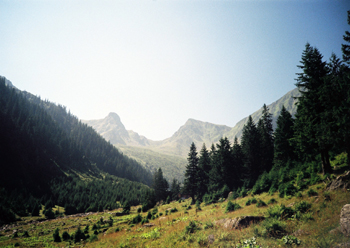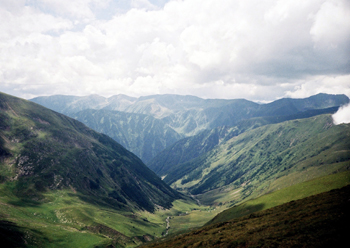Treacherous Climbs:
In the Steps of the Romanian
Anti-Communist Fighters
Irina Stelea
 Eastern Carpathian Mountains
Eastern Carpathian Mountains
Făgăraș, Romania
WGS84: 47° 0’ 0” N, 25° 30’ 0” E 47, 25.5
When summer breaks still seemed timeless, my father used to take me and other village kids on hiking trips to the mountains. Near to his village, the Făgăraş Mountains are the highest range in the Romanian Carpathians. Despite the strenuous ascent, there was always the exhilarating moment when we left the marked trails meant for most climbers, and stepped onto the wild paths known by my father and trodden only other by shepherds and hunters. These moments sparked my imagination, recalling glimpses of legends that are told in this region about brave fighters who sought refuge in the mountains. As I matured and tried to pierce the aura of these local legends, I began to consider that they might disclose far more complex and turbulent events were I to listen.
These stories do in fact refer to a historical reality that was hidden or falsified from most of the rest of the country’s population. Between the 1940s and the early 1960s, armed groups made up of young men from all social backgrounds were hiding in the Carpathian Mountains and fighting military troops in the hope of imminent outside help (particularly American) to overthrow the communist regime—a hope that never materialized. In the recent years, there were large-scale efforts by historians and researchers to reconstruct the controversial and still vague events that punctuated the existence of this Romanian anti-communist resistance movement. It is in this context that a film that tells the story of the resistance fight in the Făgăraș Mountains was made: “The Portrait of the Fighter as a Young Man” (2010, dir. Constantin Popescu Jr.). The film follows one-by-one the actions of a group of young men who were able to survive in the Făgăraș Mountains for approximately ten years, from the mid-1940s to the mid-1950s, perpetually chased by the secret police forces. With the precision of a chronicle, I watched as the film served me the raw material behind the legends of my childhood.
Due to its effort (the first of its kind) to shed light on a lost piece of Romanian history, the film was hailed by audiences, and thus often ‘got away’ with its cinematic shortcomings like: the monochrome rhythm, the insufficient character development, or the tendency to add an aura of contemporary coolness to the life of the partisans. However, any attempt to watch the film as an informative period drama that reveals a crucial chapter of history is ultimately problematic. The film draws mostly on a single historical account, as very few witnesses, each from their own narrow angle, are left to tell the story. The ideological load—like in other communist regimes—complicates matters beyond our present power to imagine, and the problem of betrayal, a constant presence in Romanian communism, adds up to a very murky picture of those times.
Generations like mine, who grew up outside the communist mantle, may not yet be prepared to understand all the implications associated with these events. From the warmth and comfort of the present-day democratic society, the idea that individuals of the same age sacrificed their lives for the sake of ideology is almost unfathomable. Even more so, in villages like my father’s, where the partisans descended from the mountains in search of supplies, this chapter of history is often intertwined with family or community narratives, and anyone seeking the ‘historical truth’ ends up on moving sands. The communist climate of suspicion is still visible today in the villagers’ reluctance to talk. Whenever I touched upon these issues in conversation, I witnessed a familiar sudden response: that person became blurry and distant, as if all these events belonged in fact to a parallel universe.
 However, “The Portrait of the Fighter as a Young Man” gave me a key to start deconstructing the legend and to understand the acts of the insurgents: the natural setting of the mountains, also one of the film’s most overlooked features. The director went to great lengths to remain truthful to historical locations (high-altitude meadows, hidden mountain passes, God-forsaken refuges), and defied the inhospitable mountainous terrain through all seasons possible. The subtle, yet overpowering vistas that depict the Făgăraș Mountains build up the natural landscape making the mountains become a character in itself. There is no room for metaphors here, however. Through its constant presence at the partisans’ every step, the natural environment insinuates itself into their lives and becomes a defining factor thereof. Some of these young rebels spent more than a decade sheltered in the mountains, and the film makes it clear that this setting worked both for and against them. In order to survive, they had no choice but to become one with these mountains, in the most basic sense. It is exactly this unmediated relationship between man and mountain that the film unfolds so well.
However, “The Portrait of the Fighter as a Young Man” gave me a key to start deconstructing the legend and to understand the acts of the insurgents: the natural setting of the mountains, also one of the film’s most overlooked features. The director went to great lengths to remain truthful to historical locations (high-altitude meadows, hidden mountain passes, God-forsaken refuges), and defied the inhospitable mountainous terrain through all seasons possible. The subtle, yet overpowering vistas that depict the Făgăraș Mountains build up the natural landscape making the mountains become a character in itself. There is no room for metaphors here, however. Through its constant presence at the partisans’ every step, the natural environment insinuates itself into their lives and becomes a defining factor thereof. Some of these young rebels spent more than a decade sheltered in the mountains, and the film makes it clear that this setting worked both for and against them. In order to survive, they had no choice but to become one with these mountains, in the most basic sense. It is exactly this unmediated relationship between man and mountain that the film unfolds so well.
As a climber, I had a similar realization: despite the vastness and grandeur of the space, the mountains are inaccessible beyond the brute experience. The natural presence is so potent and straightforward that it makes any attempt to distance oneself and reflect back on it futile. There is no ground for romanticizing thoughts, only the unmediated, humbling experience of nature at its strongest. Through direct contact with the mountains, I was able to identify a thread—albeit very thin—of familiarity with the partisans’ story. The unsympathetic environment subtly pointed me to the futility of their fight, to the willpower and risks associated with a life off the beaten path, to the feelings they must have endured. As the handful of rebels realized that no one would come to their rescue and that the military would eventually corner them, their hope turned into despair. It is difficult, if not impossible, to comprehend this tragic experience, but we could begin by bearing in mind that the mountains, with their harsh and silent presence, accompanied the fighters at their every step. And, as the director rightfully noticed, their survival in such an environment deserves perhaps as much attention as their ideological battle. Ultimately, the Făgăraș Mountains were no stage for heroic acts and no fabric for legends, but truly and simply a giant antechamber of a victory that never came to life.

Irina Stelea is a Romanian-born photographer and sometimes a graphic designer who currently works a day job for a liberal arts university in Berlin. Recently, she has been documenting village communities in her home country, seeking to understand how images can be used to the benefit of social relations.

0 comments on “Review: Eastern Carpathian Mountains”